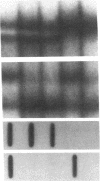Abstract
A proband with chylomicronemia, pancreatitis, and non-insulin-dependent diabetes (NIDDM) bears two different mutations in exon 3 of the lipoprotein lipase (LPL) gene: a missense mutation, 75Arg-->Ser, inherited through the paternal line and a truncation, 73Tyr-->Ter, through the maternal line. NIDDM appeared to be independently segregating. The R75S mutant was studied in extracts and media from transfected COS-1 cells. Detectable amounts of catalytically competent R75S LPL suggested destabilization of the active homodimer as with exon 5 mutants (Hata et al. 1992. J. Biol. Chem. 267:20132-20139). Hydrolysis of a short-chain fatty acid ester indicated that R75S does not directly affect activation of LPL by apoC-II. Subjects with NIDDM and wild-type LPL, and nondiabetic middle-aged carriers of the 73Tyr-->Ter truncation had moderate hypertriglyceridemia (260-521 mg/dl) and reduced high density lipoprotein cholesterol. A maternal aunt with NIDDM carried the truncation. Her phenotype (triglycerides of 5,300 mg/dl, eruptive xanthomatosis, and recurrent pancreatitis) was as severe as that in homozygotes or compound heterozygotes. We conclude: (a) diabetic carriers of dysfunctional LPL alleles are at risk for severe lipemia; and (b) the physiologic defects in NIDDM may be additive or synergistic with heterozygous LPL deficiency.
Full text
PDF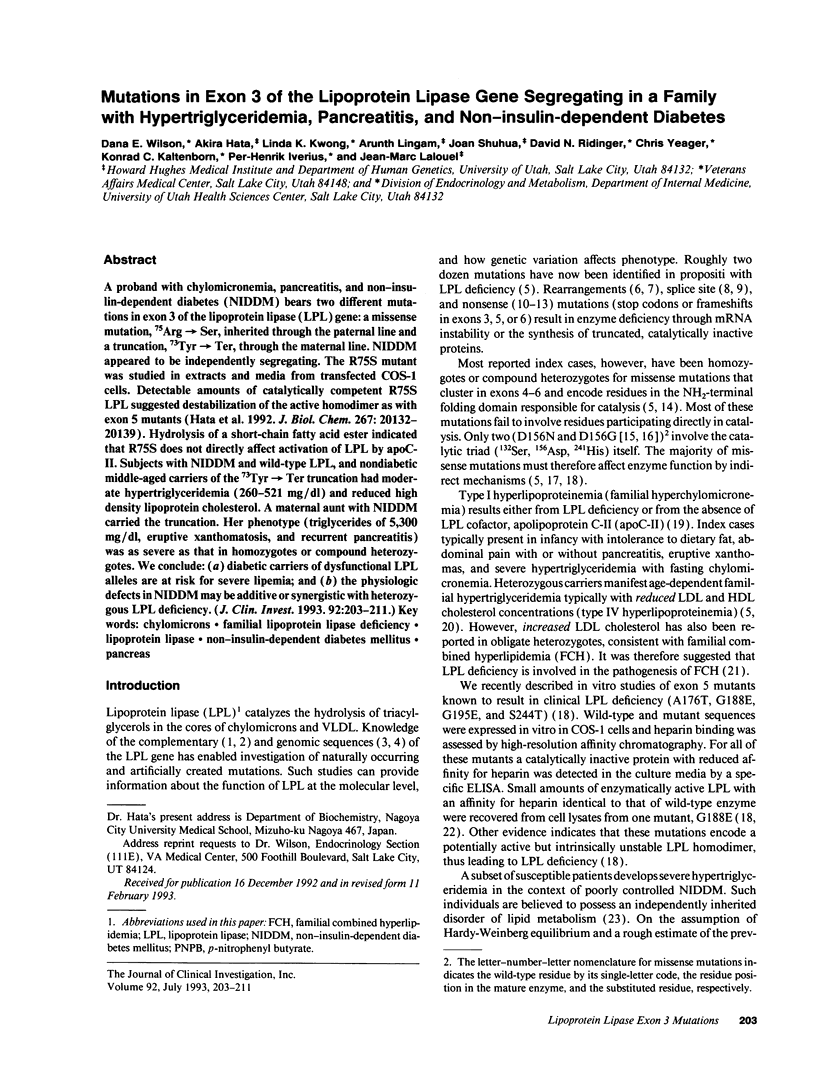
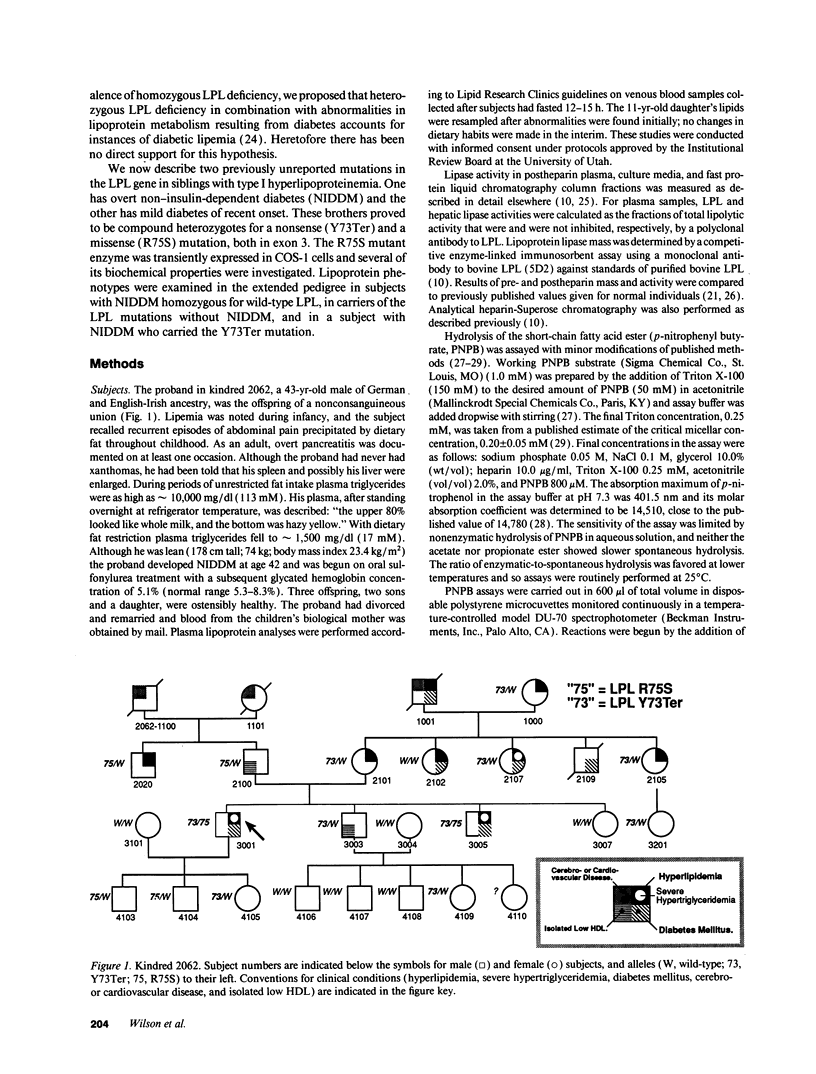
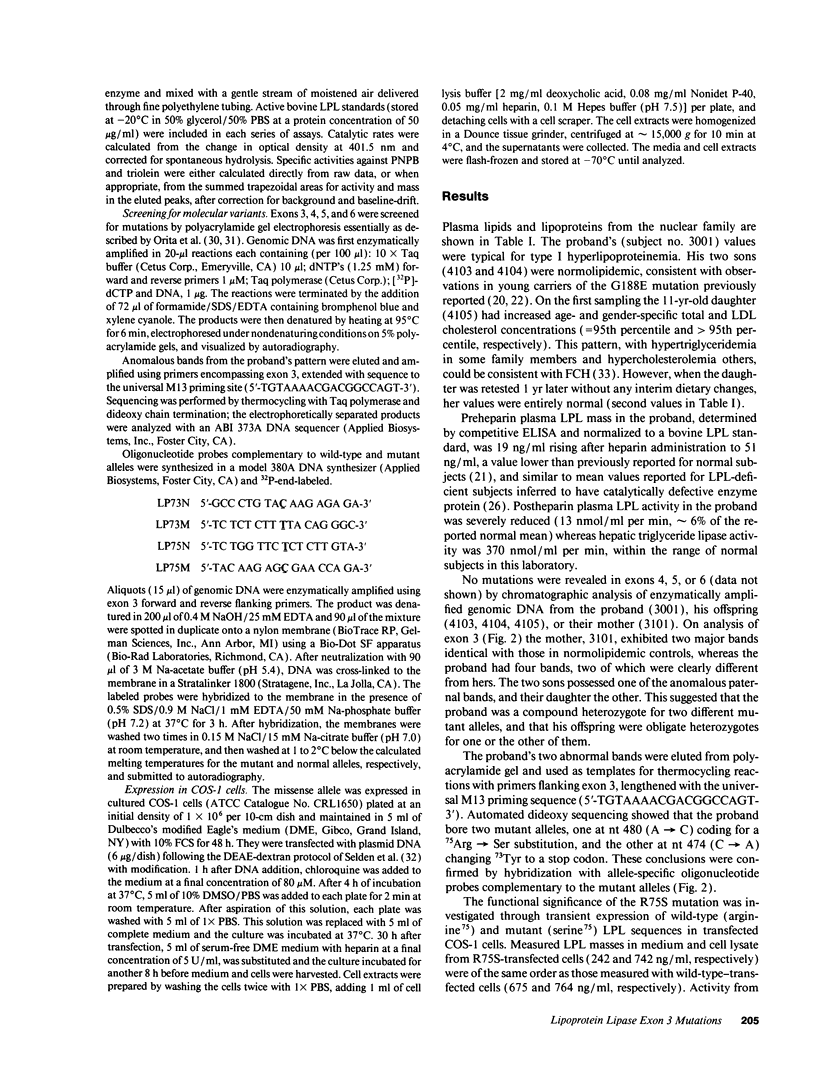
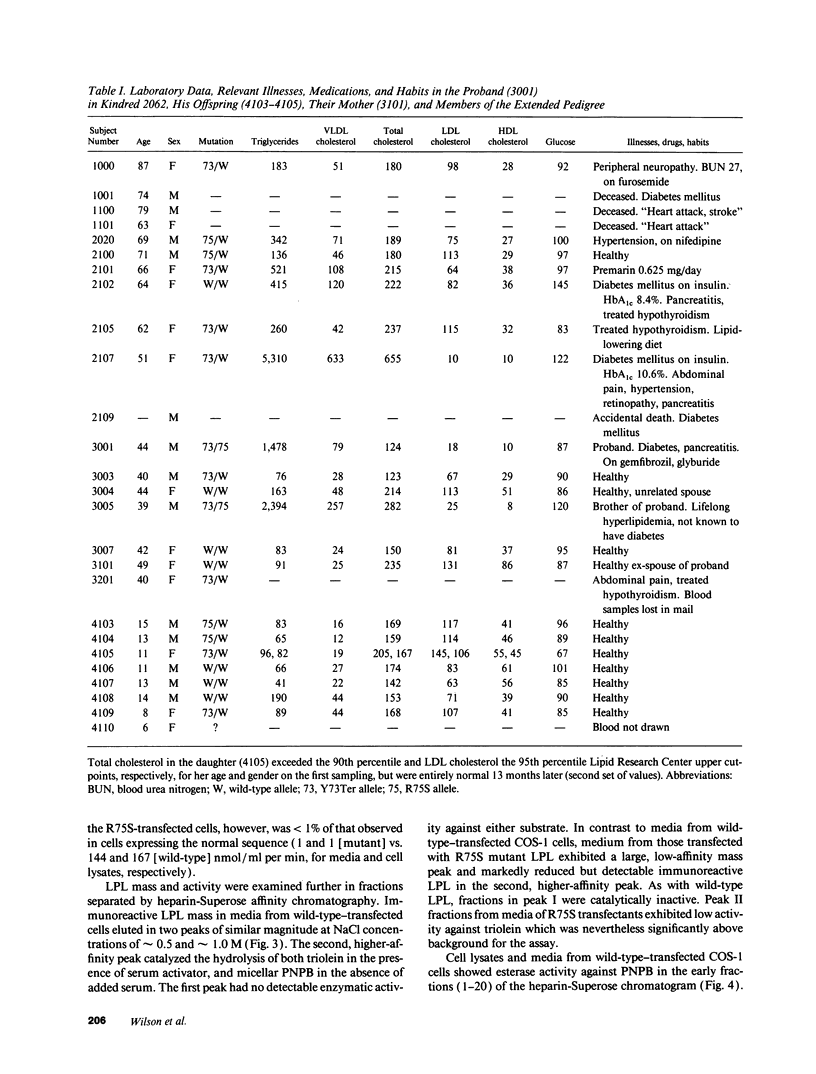
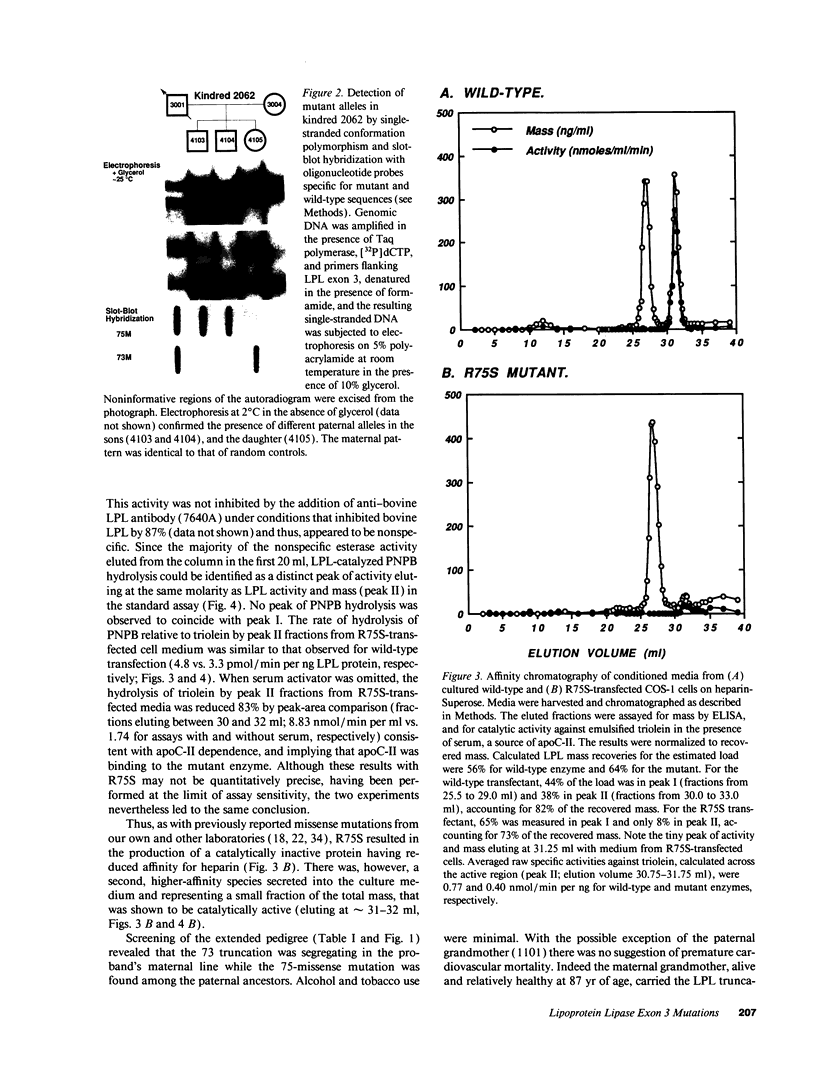
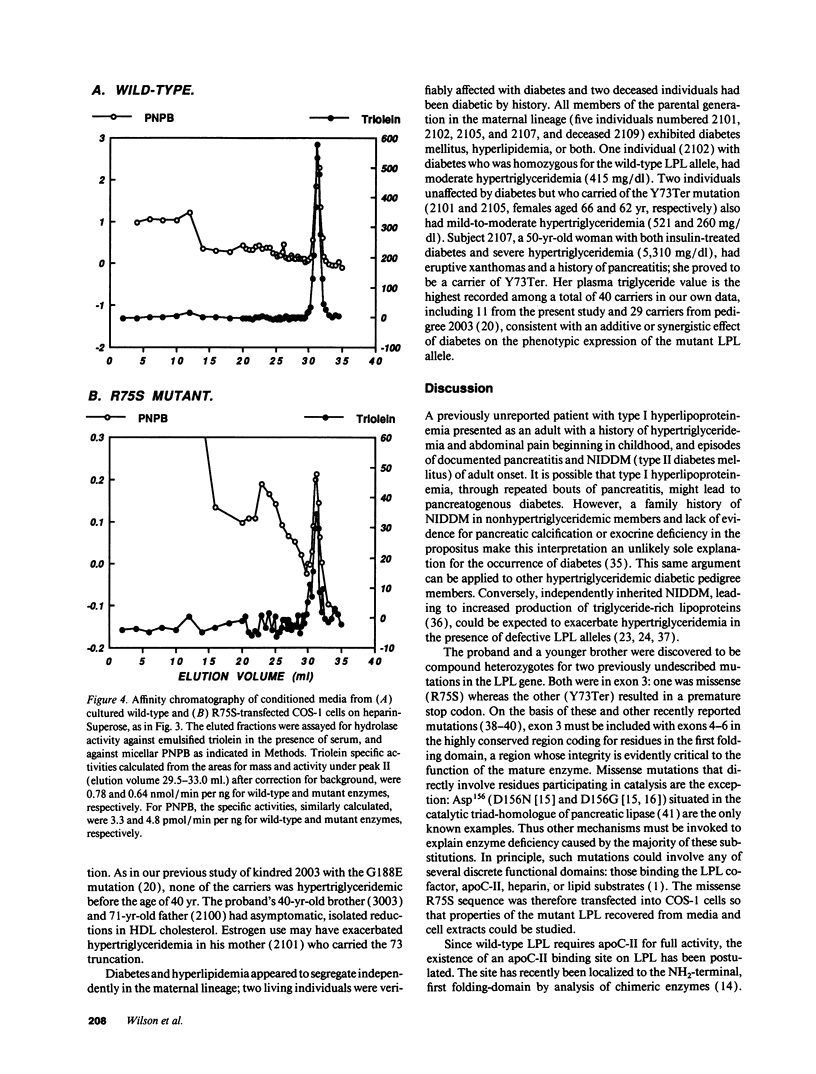
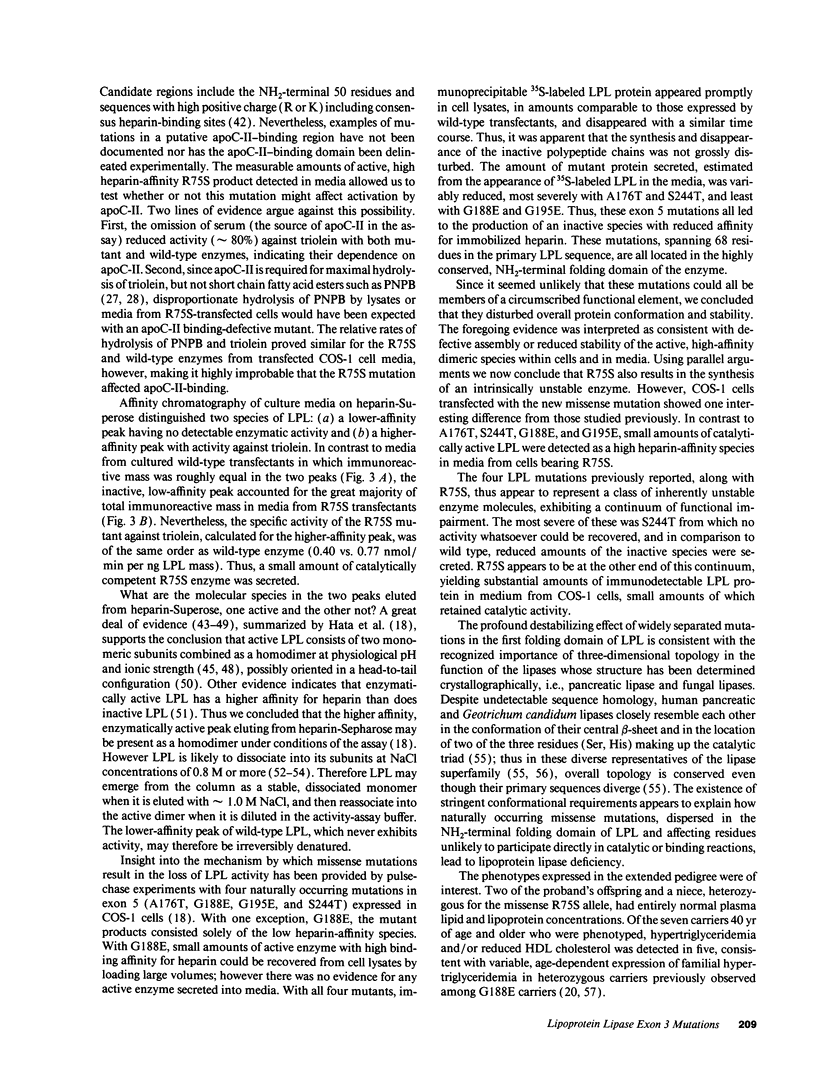
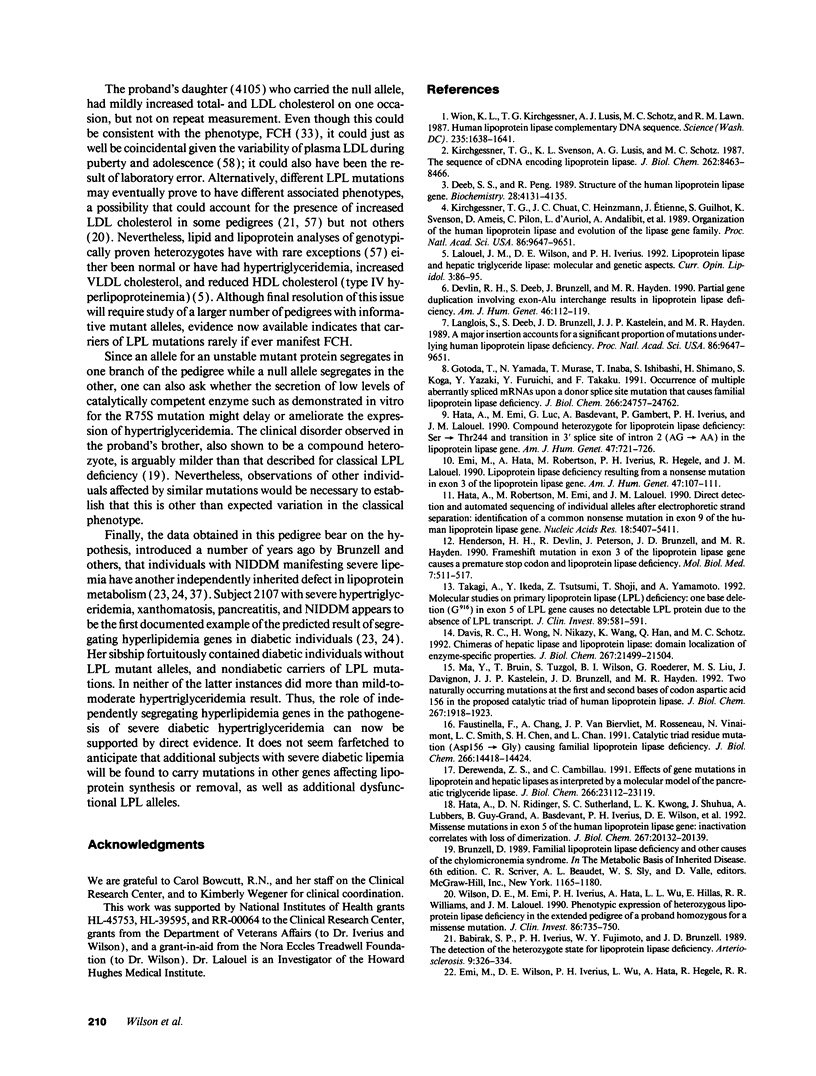
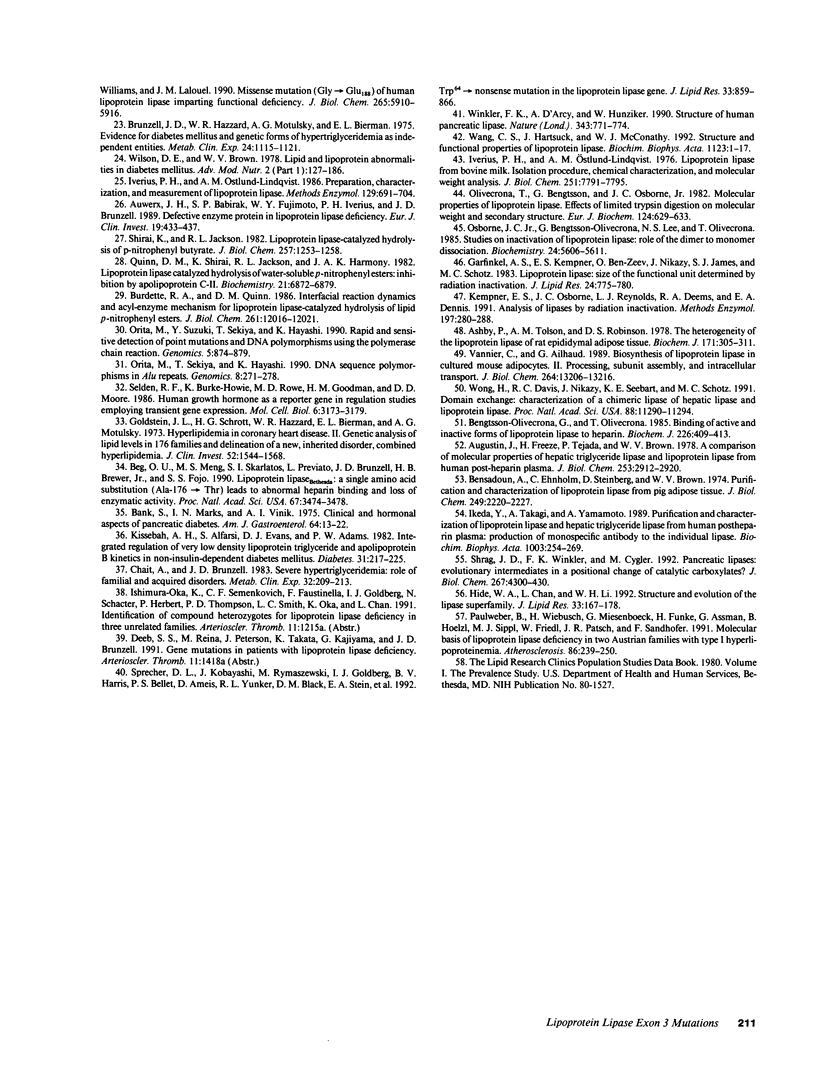
Images in this article
Selected References
These references are in PubMed. This may not be the complete list of references from this article.
- Ashby P., Tolson A. M., Robinson D. S. The heterogeneity of the lipoprotein lipase of rat epididymal adipose tissue. Biochem J. 1978 May 1;171(2):305–311. doi: 10.1042/bj1710305. [DOI] [PMC free article] [PubMed] [Google Scholar]
- Augustin J., Freeze H., Tejada P., Brown W. V. A comparison of molecular properties of hepatic triglyceride lipase and lipoprotein lipase from human post-heparin plasma. J Biol Chem. 1978 May 10;253(9):2912–2920. [PubMed] [Google Scholar]
- Auwerx J. H., Babirak S. P., Fujimoto W. Y., Iverius P. H., Brunzell J. D. Defective enzyme protein in lipoprotein lipase deficiency. Eur J Clin Invest. 1989 Oct;19(5):433–437. doi: 10.1111/j.1365-2362.1989.tb00255.x. [DOI] [PubMed] [Google Scholar]
- Babirak S. P., Iverius P. H., Fujimoto W. Y., Brunzell J. D. Detection and characterization of the heterozygote state for lipoprotein lipase deficiency. Arteriosclerosis. 1989 May-Jun;9(3):326–334. doi: 10.1161/01.atv.9.3.326. [DOI] [PubMed] [Google Scholar]
- Bank S., Marks I. N., Vinik A. I. Clinical and hormonal aspects of pancreatic diabetes. Am J Gastroenterol. 1975 Jul;64(1):13–22. [PubMed] [Google Scholar]
- Beg O. U., Meng M. S., Skarlatos S. I., Previato L., Brunzell J. D., Brewer H. B., Jr, Fojo S. S. Lipoprotein lipaseBethesda: a single amino acid substitution (Ala-176----Thr) leads to abnormal heparin binding and loss of enzymic activity. Proc Natl Acad Sci U S A. 1990 May;87(9):3474–3478. doi: 10.1073/pnas.87.9.3474. [DOI] [PMC free article] [PubMed] [Google Scholar]
- Bengtsson-Olivecrona G., Olivecrona T. Binding of active and inactive forms of lipoprotein lipase to heparin. Effects of pH. Biochem J. 1985 Mar 1;226(2):409–413. doi: 10.1042/bj2260409. [DOI] [PMC free article] [PubMed] [Google Scholar]
- Bensadoun A., Ehnholm C., Steinberg D., Brown W. V. Purification and characterization of lipoprotein lipase from pig adipose tissue. J Biol Chem. 1974 Apr 10;249(7):2220–2227. [PubMed] [Google Scholar]
- Brunzell J. D., Hazzard W. R., Motulsky A. G., Bierman E. L. Evidence for diabetes mellitus and genetic forms of hypertriglyceridemia as independent entities. Metabolism. 1975 Oct;24(10):1115–1121. doi: 10.1016/0026-0495(75)90148-1. [DOI] [PubMed] [Google Scholar]
- Burdette R. A., Quinn D. M. Interfacial reaction dynamics and acyl-enzyme mechanism for lipoprotein lipase-catalyzed hydrolysis of lipid p-nitrophenyl esters. J Biol Chem. 1986 Sep 15;261(26):12016–12021. [PubMed] [Google Scholar]
- Chait A., Brunzell J. D. Severe hypertriglyceridemia: role of familial and acquired disorders. Metabolism. 1983 Mar;32(3):209–214. doi: 10.1016/0026-0495(83)90184-1. [DOI] [PubMed] [Google Scholar]
- Davis R. C., Wong H., Nikazy J., Wang K., Han Q., Schotz M. C. Chimeras of hepatic lipase and lipoprotein lipase. Domain localization of enzyme-specific properties. J Biol Chem. 1992 Oct 25;267(30):21499–21504. [PubMed] [Google Scholar]
- Deeb S. S., Peng R. L. Structure of the human lipoprotein lipase gene. Biochemistry. 1989 May 16;28(10):4131–4135. doi: 10.1021/bi00436a001. [DOI] [PubMed] [Google Scholar]
- Derewenda Z. S., Cambillau C. Effects of gene mutations in lipoprotein and hepatic lipases as interpreted by a molecular model of the pancreatic triglyceride lipase. J Biol Chem. 1991 Dec 5;266(34):23112–23119. [PubMed] [Google Scholar]
- Devlin R. H., Deeb S., Brunzell J., Hayden M. R. Partial gene duplication involving exon-Alu interchange results in lipoprotein lipase deficiency. Am J Hum Genet. 1990 Jan;46(1):112–119. [PMC free article] [PubMed] [Google Scholar]
- Emi M., Hata A., Robertson M., Iverius P. H., Hegele R., Lalouel J. M. Lipoprotein lipase deficiency resulting from a nonsense mutation in exon 3 of the lipoprotein lipase gene. Am J Hum Genet. 1990 Jul;47(1):107–111. [PMC free article] [PubMed] [Google Scholar]
- Emi M., Wilson D. E., Iverius P. H., Wu L., Hata A., Hegele R., Williams R. R., Lalouel J. M. Missense mutation (Gly----Glu188) of human lipoprotein lipase imparting functional deficiency. J Biol Chem. 1990 Apr 5;265(10):5910–5916. [PubMed] [Google Scholar]
- Faustinella F., Chang A., Van Biervliet J. P., Rosseneu M., Vinaimont N., Smith L. C., Chen S. H., Chan L. Catalytic triad residue mutation (Asp156----Gly) causing familial lipoprotein lipase deficiency. Co-inheritance with a nonsense mutation (Ser447----Ter) in a Turkish family. J Biol Chem. 1991 Aug 5;266(22):14418–14424. [PubMed] [Google Scholar]
- Garfinkel A. S., Kempner E. S., Ben-Zeev O., Nikazy J., James S. J., Schotz M. C. Lipoprotein lipase: size of the functional unit determined by radiation inactivation. J Lipid Res. 1983 Jun;24(6):775–780. [PubMed] [Google Scholar]
- Goldstein J. L., Schrott H. G., Hazzard W. R., Bierman E. L., Motulsky A. G. Hyperlipidemia in coronary heart disease. II. Genetic analysis of lipid levels in 176 families and delineation of a new inherited disorder, combined hyperlipidemia. J Clin Invest. 1973 Jul;52(7):1544–1568. doi: 10.1172/JCI107332. [DOI] [PMC free article] [PubMed] [Google Scholar]
- Gotoda T., Yamada N., Murase T., Inaba T., Ishibashi S., Shimano H., Koga S., Yazaki Y., Furuichi Y., Takaku F. Occurrence of multiple aberrantly spliced mRNAs upon a donor splice site mutation that causes familial lipoprotein lipase deficiency. J Biol Chem. 1991 Dec 25;266(36):24757–24762. [PubMed] [Google Scholar]
- Hata A., Emi M., Luc G., Basdevant A., Gambert P., Iverius P. H., Lalouel J. M. Compound heterozygote for lipoprotein lipase deficiency: Ser----Thr244 and transition in 3' splice site of intron 2 (AG----AA) in the lipoprotein lipase gene. Am J Hum Genet. 1990 Oct;47(4):721–726. [PMC free article] [PubMed] [Google Scholar]
- Hata A., Ridinger D. N., Sutherland S. D., Emi M., Kwong L. K., Shuhua J., Lubbers A., Guy-Grand B., Basdevant A., Iverius P. H. Missense mutations in exon 5 of the human lipoprotein lipase gene. Inactivation correlates with loss of dimerization. J Biol Chem. 1992 Oct 5;267(28):20132–20139. [PubMed] [Google Scholar]
- Hata A., Robertson M., Emi M., Lalouel J. M. Direct detection and automated sequencing of individual alleles after electrophoretic strand separation: identification of a common nonsense mutation in exon 9 of the human lipoprotein lipase gene. Nucleic Acids Res. 1990 Sep 25;18(18):5407–5411. doi: 10.1093/nar/18.18.5407. [DOI] [PMC free article] [PubMed] [Google Scholar]
- Henderson H. E., Devlin R., Peterson J., Brunzell J. D., Hayden M. R. Frameshift mutation in exon 3 of the lipoprotein lipase gene causes a premature stop codon and lipoprotein lipase deficiency. Mol Biol Med. 1990 Dec;7(6):511–517. [PubMed] [Google Scholar]
- Hide W. A., Chan L., Li W. H. Structure and evolution of the lipase superfamily. J Lipid Res. 1992 Feb;33(2):167–178. [PubMed] [Google Scholar]
- Ikeda Y., Takagi A., Yamamoto A. Purification and characterization of lipoprotein lipase and hepatic triglyceride lipase from human postheparin plasma: production of monospecific antibody to the individual lipase. Biochim Biophys Acta. 1989 Jun 28;1003(3):254–269. doi: 10.1016/0005-2760(89)90231-2. [DOI] [PubMed] [Google Scholar]
- Iverius P. H., Ostlund-Lindqvist A. M. Lipoprotein lipase from bovine milk. Isolation procedure, chemical characterization, and molecular weight analysis. J Biol Chem. 1976 Dec 25;251(24):7791–7795. [PubMed] [Google Scholar]
- Iverius P. H., Ostlund-Lindqvist A. M. Preparation, characterization, and measurement of lipoprotein lipase. Methods Enzymol. 1986;129:691–704. doi: 10.1016/0076-6879(86)29099-0. [DOI] [PubMed] [Google Scholar]
- Kempner E. S., Osborne J. C., Jr, Reynolds L. J., Deems R. A., Dennis E. A. Analysis of lipases by radiation inactivation. Methods Enzymol. 1991;197:280–288. doi: 10.1016/0076-6879(91)97153-p. [DOI] [PubMed] [Google Scholar]
- Kirchgessner T. G., Chuat J. C., Heinzmann C., Etienne J., Guilhot S., Svenson K., Ameis D., Pilon C., d'Auriol L., Andalibi A. Organization of the human lipoprotein lipase gene and evolution of the lipase gene family. Proc Natl Acad Sci U S A. 1989 Dec;86(24):9647–9651. doi: 10.1073/pnas.86.24.9647. [DOI] [PMC free article] [PubMed] [Google Scholar]
- Kirchgessner T. G., Chuat J. C., Heinzmann C., Etienne J., Guilhot S., Svenson K., Ameis D., Pilon C., d'Auriol L., Andalibi A. Organization of the human lipoprotein lipase gene and evolution of the lipase gene family. Proc Natl Acad Sci U S A. 1989 Dec;86(24):9647–9651. doi: 10.1073/pnas.86.24.9647. [DOI] [PMC free article] [PubMed] [Google Scholar]
- Kirchgessner T. G., Svenson K. L., Lusis A. J., Schotz M. C. The sequence of cDNA encoding lipoprotein lipase. A member of a lipase gene family. J Biol Chem. 1987 Jun 25;262(18):8463–8466. [PubMed] [Google Scholar]
- Kissebah A. H., Alfarsi S., Evans D. J., Adams P. W. Integrated regulation of very low density lipoprotein triglyceride and apolipoprotein-B kinetics in non-insulin-dependent diabetes mellitus. Diabetes. 1982 Mar;31(3):217–225. doi: 10.2337/diab.31.3.217. [DOI] [PubMed] [Google Scholar]
- Ma Y. H., Bruin T., Tuzgol S., Wilson B. I., Roederer G., Liu M. S., Davignon J., Kastelein J. J., Brunzell J. D., Hayden M. R. Two naturally occurring mutations at the first and second bases of codon aspartic acid 156 in the proposed catalytic triad of human lipoprotein lipase. In vivo evidence that aspartic acid 156 is essential for catalysis. J Biol Chem. 1992 Jan 25;267(3):1918–1923. [PubMed] [Google Scholar]
- Olivecrona T., Bengtsson G., Osborne J. C., Jr Molecular properties of lipoprotein lipase. Effects of limited trypsin digestion on molecular weight and secondary structure. Eur J Biochem. 1982 Jun;124(3):629–633. [PubMed] [Google Scholar]
- Orita M., Sekiya T., Hayashi K. DNA sequence polymorphisms in Alu repeats. Genomics. 1990 Oct;8(2):271–278. doi: 10.1016/0888-7543(90)90282-y. [DOI] [PubMed] [Google Scholar]
- Orita M., Suzuki Y., Sekiya T., Hayashi K. Rapid and sensitive detection of point mutations and DNA polymorphisms using the polymerase chain reaction. Genomics. 1989 Nov;5(4):874–879. doi: 10.1016/0888-7543(89)90129-8. [DOI] [PubMed] [Google Scholar]
- Osborne J. C., Jr, Bengtsson-Olivecrona G., Lee N. S., Olivecrona T. Studies on inactivation of lipoprotein lipase: role of the dimer to monomer dissociation. Biochemistry. 1985 Sep 24;24(20):5606–5611. doi: 10.1021/bi00341a048. [DOI] [PubMed] [Google Scholar]
- Paulweber B., Wiebusch H., Miesenboeck G., Funke H., Assmann G., Hoelzl B., Sippl M. J., Friedl W., Patsch J. R., Sandhofer F. Molecular basis of lipoprotein lipase deficiency in two Austrian families with type I hyperlipoproteinemia. Atherosclerosis. 1991 Feb;86(2-3):239–250. doi: 10.1016/0021-9150(91)90220-w. [DOI] [PubMed] [Google Scholar]
- Quinn D. M., Shirai K., Jackson R. L., Harmony J. A. Lipoprotein lipase catalyzed hydrolysis of water-soluble p-nitrophenyl esters. Inhibition by apolipoprotein C-II. Biochemistry. 1982 Dec 21;21(26):6872–6879. doi: 10.1021/bi00269a038. [DOI] [PubMed] [Google Scholar]
- Schrag J. D., Winkler F. K., Cygler M. Pancreatic lipases: evolutionary intermediates in a positional change of catalytic carboxylates? J Biol Chem. 1992 Mar 5;267(7):4300–4303. [PubMed] [Google Scholar]
- Selden R. F., Howie K. B., Rowe M. E., Goodman H. M., Moore D. D. Human growth hormone as a reporter gene in regulation studies employing transient gene expression. Mol Cell Biol. 1986 Sep;6(9):3173–3179. doi: 10.1128/mcb.6.9.3173. [DOI] [PMC free article] [PubMed] [Google Scholar]
- Shirai K., Jackson R. L. Lipoprotein lipase-catalyzed hydrolysis of p-nitrophenyl butyrate. Interfacial activation by phospholipid vesicles. J Biol Chem. 1982 Feb 10;257(3):1253–1258. [PubMed] [Google Scholar]
- Sprecher D. L., Kobayashi J., Rymaszewski M., Goldberg I. J., Harris B. V., Bellet P. S., Ameis D., Yunker R. L., Black D. M., Stein E. A. Trp64----nonsense mutation in the lipoprotein lipase gene. J Lipid Res. 1992 Jun;33(6):859–866. [PubMed] [Google Scholar]
- Takagi A., Ikeda Y., Tsutsumi Z., Shoji T., Yamamoto A. Molecular studies on primary lipoprotein lipase (LPL) deficiency. One base deletion (G916) in exon 5 of LPL gene causes no detectable LPL protein due to the absence of LPL mRNA transcript. J Clin Invest. 1992 Feb;89(2):581–591. doi: 10.1172/JCI115624. [DOI] [PMC free article] [PubMed] [Google Scholar]
- Vannier C., Ailhaud G. Biosynthesis of lipoprotein lipase in cultured mouse adipocytes. II. Processing, subunit assembly, and intracellular transport. J Biol Chem. 1989 Aug 5;264(22):13206–13216. [PubMed] [Google Scholar]
- Wang C. S., Hartsuck J., McConathy W. J. Structure and functional properties of lipoprotein lipase. Biochim Biophys Acta. 1992 Jan 3;1123(1):1–17. doi: 10.1016/0005-2760(92)90165-r. [DOI] [PubMed] [Google Scholar]
- Wilson D. E., Emi M., Iverius P. H., Hata A., Wu L. L., Hillas E., Williams R. R., Lalouel J. M. Phenotypic expression of heterozygous lipoprotein lipase deficiency in the extended pedigree of a proband homozygous for a missense mutation. J Clin Invest. 1990 Sep;86(3):735–750. doi: 10.1172/JCI114770. [DOI] [PMC free article] [PubMed] [Google Scholar]
- Winkler F. K., D'Arcy A., Hunziker W. Structure of human pancreatic lipase. Nature. 1990 Feb 22;343(6260):771–774. doi: 10.1038/343771a0. [DOI] [PubMed] [Google Scholar]
- Wion K. L., Kirchgessner T. G., Lusis A. J., Schotz M. C., Lawn R. M. Human lipoprotein lipase complementary DNA sequence. Science. 1987 Mar 27;235(4796):1638–1641. doi: 10.1126/science.3823907. [DOI] [PubMed] [Google Scholar]
- Wong H., Davis R. C., Nikazy J., Seebart K. E., Schotz M. C. Domain exchange: characterization of a chimeric lipase of hepatic lipase and lipoprotein lipase. Proc Natl Acad Sci U S A. 1991 Dec 15;88(24):11290–11294. doi: 10.1073/pnas.88.24.11290. [DOI] [PMC free article] [PubMed] [Google Scholar]



